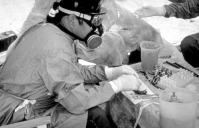Rare and Deadly Diseases: Hantavirus: Four Corners, United States
Hantavirus: Four Corners, United States
In 1993 there was an outbreak of disease in the Four Corners of the United States—where New Mexico, Arizona, Colorado, and Utah all share a border. The illness was unexplained, it occurred primarily in Native Americans, and it was characterized by acute respiratory symptoms—throat irritation, coughing, and sneezing. Thirteen people died in the 1993 outbreak.
It turned out that heavy rains in the spring had increased the food supply for rodents, and that they were spreading the disease to people. The disease was later identified as hantavirus.
Hantavirus is an RNA virus that is carried by mice and rats. Initial symptoms are nonspecific, like fever, chills, and muscle aches. The cough and severe symptoms of the disease don't usually happen until seven days after initial symptoms. Once they start, the disease progresses quickly with hospitalization and ventilation often required within 24 hours.

CDC scientist conducting hantavirus field studies by collecting specimens from trapped rodents (1993). (Courtesy CDC/Cheryl Tryon)
Set Your Mouse Traps!
The deer mouse and the cotton rat are the primary carriers of hantavirus. They shed the virus in their urine, droppings, and saliva. When these droppings are stirred up, tiny droplets of virus get into the air; this process is called aerosolization. People get the disease when they breathe air that has been contaminated by the virus. The disease is not spread from person to person, nor can it be transmitted from a blood transfusion.
Hantavirus can also be spread if someone is bitten by a rodent, which is rare, or by touching a surface that is contaminated with the virus and then touching their nose or mouth.
Disease Diction
Aerosolization is when tiny particles of a disease-causing organism become airborne and can cause disease in those who breathe them in. Hantavirus and tuberculosis are spread this way.
Disinfecting rodent-infested areas is one of the keys to preventing hantavirus. These areas include barns, sheds, warehouses, summer homes closed for the winter, or even homes people live in all year round in areas with large rodent populations.
Who Is at Risk?
People who work around barns, garages, and warehouses are at greatest risk for contracting hantavirus because of their potential exposure or proximity to mouse droppings. Hikers and campers may be at risk as well, especially if they explore vacant buildings. Depending on where you live, you can even be at some risk in your own home.

A deer mouse, the major carrier of a hantavirus that causes hantavirus pulmonary syndrome in humans. (Courtesy CDC/NCID)
Hantavirus is not common, but it has been found in about half of the states in this country.
Signs of Hanta
Symptoms usually appear one to six weeks after initial exposure to the virus. The disease, hantavirus pulmonary syndrome, starts out with fatigue, fever, and muscle aches. About half of the people who get sick also have headaches, dizziness, chills, nausea, vomiting, diarrhea, and stomach pain. Seven to 10 days after the first symptoms appear, coughing and shortness of breath begin. This is because the lungs are filled with fluid. At this point the disease becomes much more severe and often requires hospitalization.
Right now there is no treatment or cure for hantavirus pulmonary syndrome. People with advanced cases of the disease should be kept in intensive care and given oxygen to help them breathe.
Infectious Knowledge
The mice and rats that carry hantavirus don't get sick from it. They only serve as vectors, carrying it and passing it on to people.
Hanta's History
Hantavirus was first identified during the Korean War, in the early 1950s. Three thousand United States and United Nations soldiers became infected. The disease got its name because it was found near the Hantaan River in Korea. By October 1995, there were 119 confirmed cases of the disease in the United States; half of those people died.
The disease also occurs in Europe and Asia, but there it is caused by a similar virus that is not quite as deadly as the one that we have in the United States. Worldwide, 100,000 to 200,000 people are infected with this milder strain each year.

Excerpted from The Complete Idiot's Guide to Dangerous Diseases and Epidemics © 2002 by David Perlin, Ph.D., and Ann Cohen. All rights reserved including the right of reproduction in whole or in part in any form. Used by arrangement with Alpha Books, a member of Penguin Group (USA) Inc.
